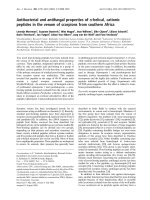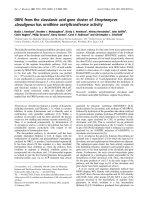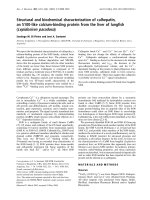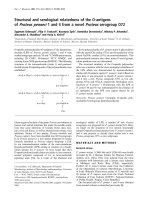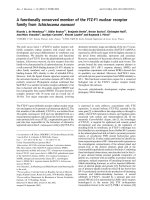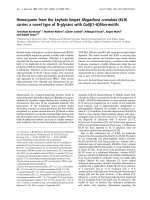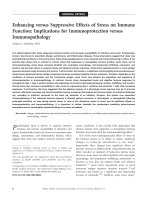Báo cáo Y học: Ferritin from the spleen of the Antarctic teleost Trematomus bernacchii is an M-type homopolymer doc
Bạn đang xem bản rút gọn của tài liệu. Xem và tải ngay bản đầy đủ của tài liệu tại đây (258.59 KB, 7 trang )
Ferritin from the spleen of the Antarctic teleost
Trematomus bernacchii
is an M-type homopolymer
Guiseppina Mignogna
1
, Roberta Chiaraluce
1
, Valerio Consalvi
1
, Stefano Cavallo
1
, Simonetta Stefanini
1
and Emilia Chiancone
1,2
1
Department of Biochemical Sciences and
2
CNR, Center of Molecular Biology, Department of Biochemical Sciences ‘A. Rossi Fanelli’,
University of Rome ‘La Sapienza’, Italy
Ferritin from the spleen of the Antarctic teleost Trematomus
bernacchii is composed of a single subunit that contains both
the ferroxidase center residues, typical of mammalian
H c hains, and the carboxylate residues forming the micelle
nucleation site, typical of mammalian L chains. C omparison
of the amino-acid sequence w ith those available from lower
vertebrates indicates that T. bernacchii ferritin can be
classified a s an M-type homopolymer. Interestingly, the
T. bern acchii ferritin chain shows 85.7% identity with a cold-
inducible ferritin chain of the rainbow trout Salmo gairdneri.
The s tructural a nd functional properties i ndicate that cold
acclimation and functional a daptation t o l ow temperatures
are a chieved w ithout significant modification o f t he protein
stability. In fact, the stability of T. bernacchii ferritintode-
naturation induced by acid or temperature closely resembles
that of mesophilic mammalian ferritins. Moreover iron is
taken up efficiently and the activation energy of the reaction
is 74.9 kJÆmol
)1
, a value slightly lower than t hat measured
for t he human recombinant H ferritin (80.8 kJÆmol
)1
).
Keywords: amino-acid sequence; cold adaptation; iron
incorporation; stability; Trematomus bernachii Antarctic fish
ferritin.
Several m olecular adaptation mechanisms have been devel-
oped by living organisms under extreme environmental
conditions [1]. In many cases, cold adaptation is achieved by
modification o f t he structural and functional properties of
proteins [2]. It follows that the correlation between the
physicochemical properties o f proteins a nd cold acclimation
is particularly attractive for molecules that are highly
thermostable [3]. This is the case for ferritin, the ubiquitous
iron-storage protein, which is c haracterized by high ther mal
and chemical s tability i n all mesophilic species [4]. Ferritins
are able to sequester and store iron in a soluble and available
form thereby protecting the organism against the toxic effect
of ÔfreeÕ iron. The extremely stable quaternary structure of
the ferritin molecule is highly conserved. It consists of a
hollow 2 4-mer p rotein shell, apoferritin (molecular mass
480 k Da), the cavity of which can accommodate up to 4500
iron atoms as an inorganic micellar core [4].
Mammalian ferritins are h eteropolymers of two genetic-
ally distinct subunits, L and H, of s imilar sequence,
molecular mass (19–21 kDa, respectively) and with the
same four-helix-bundle tertiary conformation. The ferritin
subunits are expressed in different proportions in various
cells and tissues [5]. Thus, L-rich copolymers predominate in
spleen and liver, which have an iron-storage function,
whereas H-rich f erritins are found in other tissues such as
heart and kidney, which do not [6]. Accordingly, the H
and L subunits have distinct and c omplementary functions.
The H chains contain in the four-helix bundle a dinuclear
ferroxidase center, which promotes the oxidation of Fe
2+
in
the p resence of molecular oxygen [7]. The i ron ligands are
highly conserved and are provided by residues E27, E61,
E62, H65, E107 and Q141 [7]. The L chains lack such a
center, but contain specific carboxylic groups (E57, E60,
and E64 using the H-chain numbering) facin g the inner
surface of the apoferritin shell, that provide efficient
nucleation sites for iron accumulation [8].
Ferritins f rom l ower vertebrates have re ceived r elatively
little attention. In amphibians, specifically in bullfrog
tadpole erythrocytes, the occurrence of three distinct ferritin
cDNAs and their cell-specific expression has been described.
The corresponding subunits were named H (heavy),
M (middle) and L (light) as they show distinct mobilities
in denaturing gels [9]. With respect to t he sequence elements
of functional importance, th e L chain contains the three
negatively charged residues (E57, E60, and E64) responsible
for iron nucleation and mineralization in the mammalian
protein. The H and M chains, although differing in
sequence and molecular mass, contain all the ligands of
the f erroxidase center and, in addition, two out of the t hree
carboxylic residues typical of mammalian L chains (E57
and E64, E60 is replaced by a h istidine).
In fish ferritins, evidence for two subunits was obtained by
screening of a liver cDNA library in the Atlantic salmon
Salmo salar [10]. As in tadpole ferritin, the H and M subunits
contain both the ligands typical of the H chain ferroxidase
center and the canonical L chain carboxylate residues in
positions 60 and 64. The canonical L chain glutamate
residue i n position 5 7 i s present only in the M chains a nd is
substituted by an asparagine in the H chains [8]. It is
noteworthy t hat S. salar ferritin d isplays a d ifferent pattern
Correspondence to E. Chiancone, CNR Center of Molecular Biology,
Department of Biochemical Sciences ÔA. Rossi FanelliÕ, University of
Rome ÔLa SapienzaÕ, P.le A. Moro, 5, 00185 Roma, Italy.
Fax: + 39 06 4440062, Tel.: + 39 06 49910761,
E-mail:
Abbreviation:CHCA,a-cyano-4-hydroxycinnamic acid.
(Received 2 8 September 200 1, revised 3 0 November 2001, accepted
3 January 2002)
Eur. J. Biochem. 269, 1600–1606 (2002) Ó FEBS 2002
of subunit expression relative to mammalian f erritins. Thus,
H c hains predominate in spleen and liver at variance with
thepresenceofL chainsinthesameorgansofmammals[6].
Interestingly, a study of cold-inducible gene expression of
rainbow trout cells (Salmo gairdneri) revealed that the
transcription and accumulation of the m RNA correspond-
ing to three ferritin H isoforms H1, H 2 and H3 is enhanced
[11]. In turn, the induction of ferritin H expression during
cold acclimation may suggest that this ferritin is particularly
apt to function at low temperatures.
This study was undertaken to characterize ferritin from
an Antarctic fish and thereby establish whether cold
adaptation affects t he structural–functional p roperties of
this protein. Ferritin extracted from the spleen of the
Antarctic teleost Trematomus bernacchii, which lives at a
constant temperature of )1.9 °C, was chosen. To our
knowledge only s pleen ferritin from another A ntarctic
teleost, Gymnodraco acuticeps, has been partially character-
ized; it is an H -type homopolymer, as i ndicated by the
N-terminal amino-acid sequence, that is able to accumulate
iron as an L-rich mammalian ferritin m olecule [12].
The results show that native T. bernacchii ferritin i s a
homopolymer with a h igh iron content ( 2500 iron atoms
per molecule) and a high ferroxidase activity. The amino-
acid seq uence o f the constitutive subunit shows a high
similarity to one o f the cold-inducible chains of S. gairdneri
ferritin; like this chain, it contains the functional residues
characteristic of both mammalian L and H chains. The
molecular adaptation essential to function at low tempera-
ture is not accompanied by a significant modification o f the
protein stability to chemical and physical denaturants with
respect to the mesophilic proteins.
MATERIALS AND METHODS
Enzymes a nd chemicals were purchased from the f ollowing
suppliers: Asp-N endoproteinase and trypsin from Roche
Diagnostics Corporation; pepsin and 4-vinylpyridine from
Sigma; CNBr from Fluka; guanidinium chloride (recrystal-
lized from methanol) from Merck; the liquid chromatogra-
phy solvents, HPLC-grade, from Carlo Erba Reagenti;
sequence-grade chemicals from Applied Biosystems.
Purification and characterization of
T. bernacchii
ferritin
Specimens of T. bernacchii were sam pled f rom T erra Nova
Bay Station, Ross S ea; the spleens were i mmediately
removed and frozen at )80 °C until use. Spleen ferritin
was purified following the procedure described previously
[12]. Iron was removed from the native protein, which
contains about 2500 iron atoms per molecule, by incubation
for 24 h in 0.5
M
acetate buffer, pH 4.8, containing 1%
(w/v) s odium dithionite and subsequent chelation of Fe
2+
with 2,2 ¢-bipyridyl. Th e concentration of apoferritin was
determined from the A
280
using an absorption coefficient
(e
1%,1 cm
¼ 6.5) calculated as described by Gill & Von
Hippel [13].
Analysis of amino-acid sequence
The protein sample (1.5 mg) was suspended in 0.5 mL 0.5
M
Tris/HCl, pH 7 .5, containing 2 m
M
EDTA, 4
M
guanidi-
nium chloride and 12 lmol dith iothreitol, and incubated for
3hat55°C. Thereafter, 4-vinylpyridine (90 lmol, 10 lL)
was added, and, after 10 min incubation, the protein was
desalted by HPLC using a guard c artridge (C
8
,
4.6 m m · 30 mm). A n aliquot (0.5 mg) of t he denaturated
pyridylethylated protein was dissolved in 0.2 m L 80% ( v/v)
trifluoroacetic a cid, incu bated i n the dark with 4 mg CNBr
for 24 h at room temperature, and lyophilized. A second
aliquot of protein (0.5 mg) was suspended in 0.5 mL 10 m
M
Tris/HCl, p H 7.5, c ontaining 10% acetonitrile, and incuba-
ted at 37 °C overnight after the addition of 4 lgAsp-N
endoproteinase. A third aliquot (0.3 mg) w as dissolved in
0.2 m L 5% (v/v) formic acid, and incubat ed with 6 lg
pepsin at 25 °C for 5 min. The peptide mixtures obtain ed
after enzymatic digestions were purified immediately after
the incubation with proteases, w ithout lyophiliz ation.
The peptide mixtures were p urified by H PLC using a
Beckman S ystem Gold chromatographer on a macroporous
reversed-phase column (C8208TP52; 4.6 mm · 250 mm;
5 lm Vydac; Esperia, CA, USA). T hey were eluted with a
linear gradient from 0 to 35% acetonitrile in 0.2% (v/v)
trifluoroacetic acid at a flow rate of 1.0 mLÆmin
)1
.Elution
of the p eptides w as monitored using a diode array detector
(Beckman model 168) at 220 and 280 n m.
The amino-acid sequence of peptide samples was deter-
mined b y a utomated Edman degradation using an Applied
Biosystems model 476A sequencer. S amples (0.1–0.5 nmol)
were loaded on to poly(vinylidene difluoride) membranes
(ProBlott; App lied Biosystems), coated with 2 lL polyb rene
(100 mg ÆmL
)1
; 5 0% methanol), and run with a B lott
cartridge using an optimized gas-phase fast program.
N-Terminal sequence analysis of the protein was per-
formed on samples (5 lg) electrotransferred on ProBlott
membranes a fter SDS/PAGE [14], using a liquid-phase fast
program.
Peptides were numbered retrospectively according to
their location in the sequence, starting from the N-terminus.
CNBr p eptides were designated with B, Asp-N peptides
with A, and peptic peptides with P.
MS analysis
Matrix-assisted laser desorption ionization time-of-flight
(MALDI-TOF) measurements were performed using a
Voyager-DE (Applied Biosystems) mass spectrometer.
Solutions (1 lL) containing peptides (1–5 pmol) were mixed
with 1 lL of t he m atrix solution: 30% aqueous solution of
acetonitrile and 0.1% trifluoroacetic acid saturated with
a-cyano-4-hydroxycinnamic a cid ( CHCA) or 2 ,5-dihydroxy-
benzoic acid d issolved in water. The mixture of peptide and
matrix was placed on the MALDI stainless-steel plate and
allowed to dry spontaneously. Ions were generated by
irradiating the sample area with a nitrogen laser at a
wavelength of 337 nm. Calibrations were carried out using a
mixture o f angiotensin I (1297.51 MH
+
), adrenocortico-
tropic hormone ACTH (clip 1–17) (2094.46 MH
+
), ACTH
(clip 18–39) (2466.72 MH
+
), ACTH (clip 7–38) (3660.19
MH
+
) and bovine insulin (5734.59 MH
+
) (Sequazime
TM
Peptide Mass Standards kit; Applied B iosystems).
Mass analysis of the N-terminal-blocked peptide
An aliquot (10 lg) of pyridylethylated protein was dissolved
in 50 lL50m
M
NH
4
HCO
3
, pH 8.5, and incubated a t
Ó FEBS 2002 Homopolymeric M-type T. bernacchii ferritin (Eur. J. Biochem. 269) 1601
37 °C overnight after addition of 1 lg trypsin. T he peptide
mixture w as desalted using the ZipTipC18 (Millipore) and
then mixed with the matrix solution (a-cyano-4-hydroxy-
cinnamic acid) for MALDI-TOF MS analysis.
Structure comparison
A search of the SwissProt-TrEMBLE database, pairwise
and m ultiple s equence a lignments, and prediction of s econ -
dary structures were carried out with the programs from
EXPASY
(Expert P rotein Analysis System) proteomics s erver
of the Swiss Institute of Bioinformatics (SIB).
Iron incorporation experiments
Iron incorporation experiments were performed by addition
of a f reshly prepared anaerobic solution o f ferrous amm o-
nium sulfate to an air-equilibrated solution o f apoferritin.
T. bern acchii and h uman recombinant a poferritins were
used in parallel experiments. Human recombinant
H homopolymer (100% H subunit) was overexpressed in
Escherichia c oli and purified essentially as described by Levi
et al . [15].
The kinetics of i ron oxidation and u ptake w ere followed
at the desired tem perature measuring the absorbance o f the
ferric o xide hydrate micelle at 310 nm u sing the absorption
coefficient of ferritin iron, e
1%,1 cm
¼ 450 [16]. As a control,
therateofFe
2+
autoxidation was m easured i n p arallel. To
assess iron incorporation, at the end o f the reaction the
samples were analyzed by nondenaturing gel electrophoresis
(staining with Prussian blue for i ron and Coomassie blue for
protein) and by sedimentation velocity in a B eckman
Optima XL-A analytical ultracentrifuge at 49 000 g and
10 °C. The s edimentation coefficients w ere reduced to s
20, w
by standard procedures.
Analysis of the state of association
The state of association was analysed by size- exclusion
chromatography experiments at 20 °C on a Superose 12
column (Pharmac ia) eluted w ith 20 m
M
sodium phosphate,
pH 7.0, containing 0.15
M
NaCl at a flow rate of
0.5 m LÆmin
)1
controlled b y a Dionex gradient pump. After
24 h incubation at pH 1.5–4.0, the samples were diluted
20-fold i nto the column injection loop. The Superose
column was calibrated with horse spleen apoferritin
(440 kDa, elution volume V
e
¼ 7.8 mL), rabbit muscle
aldolase (161 kDa, elution volume V
e
¼ 9.2 mL), horse
liver alcohol dehydrogenase (80 kDa, elution v olume V
e
¼
9.8 m L), BSA (66 kDa, elution volume V
e
¼ 10.0 mL),
ovalbumin (45 kDa, elution volume V
e
¼ 10 .3 mL), and
cytochrome c (12 k Da, elution volume V
e
¼ 12.4 mL).
pH-dependence experiments
T. bern acchii ferri tin (0.03–1.2 m gÆmL
)1
) w as incubated for
24 h at 20 °CatpH1.5(31.6m
M
HCl), pH 2.0 (10.0 m
M
HCl), pH 2.5 (3.2 m
M
HCl), pH 3.0 (1.0 m
M
HCl) and
pH 2.0 in the presence of 31.6 m
M
NaCl (pCl 1.5). T he pH
of the s olutions was measured with a n I nLab 422 electrode
(Mettler–Toledo AG) connected to a Corning P507 ion
meter before and after the addition of the protein. After
24 h incubation at 20 °C, the samples were analyzed by CD,
fluorescence spectroscopy, and size exclusion chromato-
graphy.
Spectroscopic methods
Intrinsic fluorescence emission and light-scattering measure-
ments were carried out with an LS50B PerkinElmer
spectrofluorimeter using a 1-cm pathlength quartz cuvette.
Intrinsic fluorescence emission spectra were recorded at
300–400 nm (1 nm sampling interval) with the excitation
wavelength set at 295 nm. Light scattering was measured
with both excitation and emission wavelength set at 480 nm.
CD spectra were recorded on a J asco J-720 spectropolari-
meter. Far-UV (190–250 nm) and near- UV CD (250–
310 n m) measurements were performed in a 0.1-cm and
1.0-cm pathlength quartz c uvette, respectively. The r esults
are expressed as mean residue ellipticity ([Q]) assuming a
mean residue weight of 110 per amino-acid residue. A ll the
spectroscopic measurements were performed at 20 °C.
Thermal denaturation
For thermal scans, the protein samples (0.06 mgÆmL
)1
)in
20 m
M
sodium phosphate at pH 7.0 and in 40 m
M
glycine/
HCl at pH 4 .0 were heated from 10 to 95 °Cand
subsequently cooled to 10 °C with a heating/cooling rate
of 1 degreeÆmin
)1
controlled by a Jasco programmable
Peltier element. Far-UV CD spectra were recorded every 5
or 2.5 °C, and the dichroic activity at 222 nm was m onit-
ored continuously every 0 .5 °C with 4 s averaging time. All
the spectra were corrected for the solvent contribution at the
different temperatures and pH values examined. The
melting temperatures were determined by taking the first
derivative of the ellipticity signal at 222 nm with respect to
temperature.
RESULTS
Determination of amino-acid sequence
The complete sequence o f the single subunit t hat gives rise
to T. bernacchii ferritin is reported in Fig. 1. The subunit
contains 176 amino-acid residues. T he seq uence was
deduced after the isolatio n and identification of an almost
complete set of CNBr peptide s, which were ordered w ith the
help of overlapping peptides produced by Asp-N a nd pepsin
cleavage. The sequence of each peptide was c onfirmed by
MS analysis. The automated Edman degradation o f the
native protein was unsuccessful for the possible p resence o f
a blocked N-terminus. MALDI-TOF MS an alysis of a
tryptic digest of the protein indicated for the N-terminal
peptide MDSQVR a value of m/z 777, which points t o the
presence of acetylme thionine. This r esidue is commonly
found in the N-terminus of eukaryotic proteins together
with N-acetyl Ala, Ser, Gly and Thr [17].
Secondary-structure prediction, performed as described
by Rost [18] shows the presence of four ahelices in the
regions corresponding to positions 8–40, 45–75, 94–120 and
128–158 (Fig. 2). This four-helix pat tern is analogous to the
four-helix-bundle characteristic of mammalian ferritin [ 4].
A search i n the SwissProt-TrEMBLE Database with the
T. bern acchii ferritin as a p robe re trieved many ferritin
sequences. The alignment, obtained using the program
1602 G. Mignogna et al.(Eur. J. Biochem. 269) Ó FEBS 2002
CLUSTALW
, is r eported in F ig. 2 where, for the sake of
simplicity, only the human L and H chains are shown to
represent m ammalian ferritins. T he percentage identity
among the various sequences ranges from 87.5 to 59, the
latter value pertaining to human L chains. The most similar
to the T. bernacchii constitutive chain are the H2 chain from
S. ga irdneri (87.5%) and the M chains from S. salar
(86.9%) and Gillichthys m irabilis (78.7%). The percentage
identity for the H c hains from S. salar and
Oncorhynchus nerka is significantly lower (70.5 and 70.4,
respectively). Despite the paucity of available sequence data,
it appears that T. bern acchii ferritin can be classified as an
M homopolymer and that the H2 chain from S. gairdneri
should be likewise considered an M chain.
The amino-acid residues of functional relevance in
mammalian L and H chains are a ll conserved in the
T. bernacchii spleen ferritin chain. More specifically, E27,
E61, E62, H65, E107 and Q141, correspond to amino acids
characteristic of the H-chain ferroxidase site, while E57,
D60 and E64 correspond to sites of iron nucleation in
L c hains. This characteristic, first described for the poly-
peptide chains of bullfrog f erritin [9], is common to fish
ferritins on the basis of the available sequences.
A further distinctive property of t he fish H chains known
to date relative to those o f mammals appears to be the lack
of the four-amino-acid extension at the N-terminus.
An exception is t he H c hain of G. acuticeps spleen ferritin,
the N -terminal amino-acid sequence of which,
TTASTSQVRQNYHQDSE, shows the typical four-ami-
no-acid extension of mammalian ferritin H chains [12].
Iron incorporation
Iron uptake by T. bern acchii apoferritin was studied at
different temperatures in 50 m
M
Mops/NaOH buffer at
pH 6.5 after the aerobic addition of 500 iron atoms per
molecule. In parallel, the recombinant human H homopoly-
mer w as examined. As shown i n Fig. 3, at 20 °Cthetime
course of Fe
2+
oxidation by T. bernacchii apoferritin is
characterized by a half-time of about 120 s, which is h igher
than that measured under s imilar conditions fo r the human
H homopolymer (t
1/2
¼ 55 s) and significantly lower than
that of the L -rich apoferritin of horse spleen (t
1/2
¼ 60 0 s)
[19]. The iron-oxidation capacity is maintained by
T. bernacchii apoferritin at low temperature; the rate of
the reaction is r educed sixfold (t
1/2
¼ 715 s) when the
temperature is decreased from 20 °Cto4°C. The human
recombinant H homopolymer shows a similar decrease in
the catalytic activity (t
1/2
¼ 360s)at4°C. The effect of
temperature on t he half-time of t he iron-oxidation reaction,
measured between 4 °Cand50°C, was a nalysed using
the Arrhenius equation. The a ctivation energy, E
a
,of
T. bernacchii apoferritin i s 74.9 k JÆmol
)1
, a value only
slightly lower than that measured for the recombinant
H protein (80.8 k JÆmol
)1
).
All t he added iron is incorporated inside the apoferritin
shell as i ndicated by native g el electrophoresis and s edimen-
tation velocity experiments. The reconstitution products
obtained o n i ncubation of apoferritin with 2500 iron a toms
Fig. 1. Complete amino-acid sequence of T. bernacchii ferritin. The
extent of the various fragments used t o r eco nstruct the sequence i s
shown. B, CNBr peptides; A, Asp-N peptides; P, peptic peptides.
Ac-M, acetylmethionine.
Fig. 2. Amino-acid sequence comparison among T. be rnacchii ferritin
and M, H a nd L chain of ferritins. The alignment was obtained using
ClustalW. TbS_M,MchainfromT. bernacchii spleen; SgG_H2 ,H2
chain f rom S. gairdneri gonadal fibroblast (TrE MBL accession num-
ber: P79822); SaL_M,MchainfromS. salar liver (SwissProt acces-
sion number: P49947); GmL_M,MchainfromG. mirabilis liver
(TrEMBL accession number: Q9DFP0); SaL_H,Hchainfrom
S. salar liver (SwissProt accession number: P49946); OnB_H,Hchain
from O. nerka brain (TrEMBL accession number: Q98TT0); HuL_H,
H ch ain from human liver (SwissProt accession number: P02794);
HuL_L, L cha in from h uman liver (SwissProt accession number:
P02792). Residues conserved in all sequences are in boldface type.
Amino acids that constitute the H-chain ferroxidase center are in blue;
those forming the L chain iron micelle nucleation site are in red. Green
arrows indicate the four predicted a helices(A,B,C,D).Yellowboxes
indicate the a helix (A, B, C, D and E) identified in the crystallographic
structure of h uman H c hain. The human H chain n umbering has been
adopted.
Ó FEBS 2002 Homopolymeric M-type T. bernacchii ferritin (Eur. J. Biochem. 269) 1603
per m olecule in Mops/NaOH buffer, pH 6.5, sediment as a
heterogeneous peak with an average sedimentation coeffi-
cient of about 43 S. The distribution of iron micelles and the
value of the sedimentation coefficient are very similar to
thosemeasuredforthenativeprotein.
Structure of
T. bernacchii
ferritin as a function of pH
The e ffect of low p H o n t he association state of the protein
was investigated to compare the stability of T. bernacchii
ferritin with that o f L-type a nd H-type mammalian ferritins,
which are known to dissociate at pH 2.5 and 2.8–3.0,
respectively [20].
The stability of T. bernacchii ferritin at acid pH values
was studied after incubation of the apoprotein in the pH
range 3.0–1.5 at 20 °C for 24 h, a time established to be
sufficient to reach equilibrium. T. bernacchii apoferritin
maintains its quaternary assembly when incubated at
pH 3.0 and at pH 2.5, as indicated by the corresponding
elution volumes from a Superose 12 column, w hich are
decreased only slightly (V
e
¼ 7.7 mL) compared with that
of the native protein at pH 7.0 (V
e
¼ 7.8 mL). On
incubation at pH 3.0, the s econdary structure of native
apoferritin i s a lmost completely preserved, a s indicated by
the far-UV C D s pectrum (Fig. 4A). Likewise, the near-UV
CD spectrum resembles that measured at pH 7.0 with
minor differences (Fig. 4B). Consistently with the modest
changes observed i n t he near-UV and far-UV CD spectra
compared with the protein at pH 7.0, the fluorescence
emission of apoferritin at pH 3.0 is decreased by only 20%,
and is not red-shifted relative to the protein at pH 7.0,
which shows a k
max
¼ 333 nm on excitation at 295 nm
(Fig. 4 C).
Incubation of T. be rnacchii apoferritin at pH 2.5 (3.2 m
M
HCl) does not induce any change in the Superose 12 elution
profile, but alters significantly the protein spectral proper-
ties. The near-UV CD s pectrum displays a consistent
decrease in all t he aromatic residue contributions. Interest-
ingly, the 262 nm phenylalanine band is of opposite sign t o
the protein a t pH 7.0 (Fig. 4B). The f ar-UV CD spectrum
of T. bernacchii apofer ritin at pH 2.5 shows a modest blue
shift of the zero intercept and an overall decrease in the
ellipticity relative to the protein at pH 7.0 (Fig. 4A). The
fluorescence spectrum c oncomitantly shows a 47% quench-
Fig. 3. Progress curves of iron oxidation uptake by T. bernacchii and
human recombinant H apoferritins on addition of 500 Fe atoms/molecule
as ferrous ammonium sulfate at 20 and 4 °C. T. bernacchii apof erritin
(– ) –20°C, –
ÆÆ
–4°C); human recomb inant H homopolymer
(–20 °C, ÆÆÆÆ 4 °C). Prot ein concentration: 0.2 l
M
.Buffer:50m
M
Mops/NaOH, pH 6.5. Inset: effect of temperature on t
1/2
value in
T. bernac chii (d) and human recombinant H homopolymer (j)
(Arrhenius plot).
Fig. 4. Effect of p H on the spectral properties of T. bernacchii ferritin. (A) Far-UV CD (0.1 cm quartz cuvette) a nd (C) fluorescence (295 nm
excitation wavelength) spectra were recorded at 0.05 mgÆmL
)1
protein concentration. (B) Near-UV CD spectra were recorded in a 1-cm
quartz cuvette at 1.20 mgÆmL
)1
protein concentration. All the s pectra were recorded at 20 °C a fter 24 h incubation of the p ro tein at pH 7.0
(20 m
M
sodium phosphate, –––), pH 3.0 (1.0 m
M
HCl, – Æ –), pH 2.0 (10.0 m
M
HCl, —–), pH 2.5 (3.2 m
M
HCl, –
ÆÆ
–), pH 2.0 pCl 1.5
(31.6 m
M
NaCl – ) –), and pH 1 .5 (31.6 m
M
HCl, ÆÆÆÆÆÆ).
1604 G. Mignogna et al.(Eur. J. Biochem. 269) Ó FEBS 2002
ing of the maximum emission intensity and a red shift of the
k
max
to 345 nm compa red with the protein at pH 7.0.
Incubation of T. bernacchii apoferritin at p H 2.0 (10 m
M
HCl) and 1.5 (31.6 m
M
HCl) results in the disassembly o f
the quaternary structure, a s indicated by the shift of the size-
exclusion chromatography elution volume from 7.8 mL
(pH 7 .0) to 11.4 mL. The de polymerization of T. bernacchii
apoferritin incubated at pH 2.0 and 1.5 is paralleled by a
significant loss in secondary structure as indicated by the
far-UV CD spectra. The spectra are characterized by a
significant decrease in ellipticity relative to pH 3.0, a blue
shift of the z ero intercept, and a change in the ratio between
the 208 and the 222 nm ba nds (Fig. 4A). In particular, the
molar ellipticity ratio ([Q
222
]/[Q
208
]) shifts from 1.46 at
pH 7.0 to 0.84 a t pH 2.0. A weakening of the protein
tertiary contacts at pH 2.0 and 1.5 is indicated by the
intrinsic fluorescence spectra, which display a red shift of the
emission maximum to a k
max
value of 351–352 nm,
accompanied b y a notable quenching of the intensity
(Fig. 4 C). T he addition of chloride to the protein at
pH 2.0 did not affect significantly the protein spectral
properties except for a blue shift of the k
max
value to
349 nm, possibly caused by charge s hielding, which leads to
a decrease in the repulsive e ffect.
A set of experiments was performed on native ferritin
containing about 2500 Fe atoms per polymer. The presence
of an iron core does not influence the acid-induced
dissociation o f the protein. Thus, the elution p rofiles from
a Superose 12 column of native ferritin at pH 7.0 and of the
protein incubated f or 24 h a t pH 3 .0–1.5 are comparable t o
those of the apoprotein (data not shown).
Thermal denaturation
The temperature-induced far-UV CD changes in
T. bernacchii apoferritin w ere mon itored continuously at
222 nm at two pH values, 7.0 and 4.0. The observed
transitions were irreversible, and the spectra measured at
the end of the cooling phase were different f rom those of
the native a poprotein. The m idpoints of t he tran sitions at
pH 7.0 a nd p H 4. 0 correspond to 82 and 7 4 °C,
respectively (data not shown). These values are closer
to those m easured in mammalian H-type ferritins (77
and 67 °C)thantothosemeasuredinL-richapoferritin
(93 and 90 °C) [21].
DISCUSSION
The p resent characterization of ferritin f rom t he Antarctic
fish T. bernacchii describes for the first time the s tructural
and functional properties of a homopolymer constructed
from an unusual s ubunit, the M chain, which i s capable of
carrying out both t he iron-oxidation and the i ron-mineral-
ization process. In the mammalian proteins, these two
reactions are c arried out by two distinct chains. The stability
of the T. bernacchii homopolymer does not differ signifi-
cantly from that of mesophilic ferritins, indicating that c old
acclimation does not significantly affect the quaternary
construction.
The a mino-acid s equence of the T. bernacchii polypeptide
chain shows the presence of b oth the amino-acid residues at
the ferroxidase center of the m ammalian H chains and t he
carboxylate g roups, w hich promote iron incorporation and
mineralization in the mammalian L chains [4]. In accord-
ance with the sequence d ata, the T. be rnacchii ferritin
homopolymer is able to both oxidize and accumulate iron
efficiently (Fig. 3). Ferritin from the spleen of another
Antarctic teleost, G. acuticeps , likewise is a homopolymer
that is rich in iron [12]. It appears therefo re that Antarctic
fish ferritins do not require heteropolymeric assemblies to
take up iron efficiently because of the structural character-
istics of the constituent polypeptide chain.
A previous comparison of amino-acid sequences from
homologous proteins from mesophiles and psychrophiles
established that a number of specific amino-acid substitu-
tions occur i n cold-adapted proteins [ 22]. However, t he
paucity of available M -type chain sequences does not
warrant such an analysis. I n this connection, it is of interest
that the t hermal stability o f the apoferritin m olecule, a
property exploited during the purification process, is very
similar in T. bernacchii ferritin and in the m esophilic
proteins. Thus, in thermal denaturation experiments at
pH 7.0 and 4.0, T. bernacchii ferritin has melting points that
are closer to those of the recombinant human H-type
protein t han to the L-type one [21]. This behavior may be
attributed at least in part to the absence o f the salt bridge
formed within the four-helix bundle of the L c hains between
K62 and E107 and thought to play a special role in
conferring thermal stability [20]; in the T. bernacchii
M c hain, just as in the human H chains, a glutamate
replaces lysine in position 62.
The stability of T. be rnacchii ferritin at acid pH values
likewise r esembles that of mesophilic mammalian ferritins,
because the polymeric assembly is maintained at pH 2.5
[20]. At p H 3.0, t he tertiary structure o f T. bernacchii
ferritin is essentially unchanged with r espect to neutral
pH. The slight decrease in intrinsic fluorescence is
probably due to dynamic quenching caused by minor
tertiary structure perturbations leading to an increased
mobility of the W93 s ide chain. At pH 2 .5, the quaternary
assembly is not altered, as indicated by size exclusion
chromatography. However, changes in protein tertiary
structure occur, as indicated by the near-UV CD and
fluorescence spectra (Fig. 4B,C). The ellipticity attribut-
able to tryptophan and tyrosine residues d ecreases; in
accordance with these findings, the fluorescence intensity
decreases and the e mission wavelength shows a modest
shift towards the red, indicating further exposure of the
W93 residue to solvent. Interestingly, the CD band a t
262 nm attr ibutable to phenylalanine residues c hanges
sign, possibly b ecause of t he presence of several pheny-
lalanines a t o r n ear t he subunit contact areas. Collectively
these changes point to a quaternary construction with
increased local flexibility at t he interfaces. A t pH 2 .5,
most of the protein secondary-structure elements are
present a s indicated by t he far-UV CD spectrum
(Fig. 4 A), w hich shows only a modest blue shift of the
zero intercept and a s mall decrease in the overall ellipticity
with respect to the p rotein at pH 7.0 and 3.0. Such
secondary-structure elements may provide t he residual
tertiary cont acts necessary to maintain the quaternary
structure of the protein. Below pH 2 .5, where the protein
dissociates, t he depolymerization process is accompanied
by the almost complete loss of secondary structure. This is
indicated by t he significant decrease in dichroic activity in
the far-UV, and by the progressive exposure of W93 to
Ó FEBS 2002 Homopolymeric M-type T. bernacchii ferritin (Eur. J. Biochem. 269) 1605
solvent shown by the red shift of the maximum emission
fluorescence wavelength relative to the protein at pH 3.0.
Analysis of the iron-incorporation process is i n accord-
ance with the presence in T. bernacchii ferritin of the
ferroxidase center residues t ypical of mammalian H-type
ferritin. Thus, the reaction rate is comparable in the two
proteins over the whole temperature range explored
(Fig. 3 ). The lower E
a
value observed in T. bernacchii
compared with the H homopolymer is consistent with
reports on other cold-adapted proteins; it may be considered
as a common mechanism of adaptation at low temperatures
[23]. T his finding suggests an i ncrease i n local flexibility in
relevant positions of the structure. On the basis of s tructural
and o r f unctional data, increased local or global flexibility of
cold-adapted proteins is often, but not always, implicated in
cold adaptation [24,25]. It follows that a combination of
different strategies is adopted by organisms to survive at low
temperatures [24].
In conclusion, this study shows that ferritins from
Antarctic fish can be a ssembled from only one subunit in
line with previous preliminary observations [12]. The M-type
chain in T. bernacchii ferritin carries the a mino acids that
confer on the homopolymer the capacity to carry out
efficiently the two processes that lead to incorporation o f iron
in the apoferritin shell, namely iron oxidatio n and nucleation
of the iron core. The high s equence s imilarity between
T. bern acchii ferritin and the cold-inducible H2 chain of
S. gaird neri supports the c ontention [11] that t he expression
of such protein s plays a significant role in cold acclimation.
ACKNOWLEDGEMENT
This research was supported by the Italian N ational Programme for
Antarctic Research (PNRA).
REFERENCES
1. Jaenicke, R. (1991) Protein s tability and molecular adaptation to
extreme conditions. Eur. J. Biochem. 202, 715–728.
2. Somero, G.N . (1995) Proteins and temperature. Annu. Rev.
Physiol. 57 , 43–68.
3. Ciardiello, M.A., Camar della, L ., Carratore, V. & Di Prisco, G.
(2000) L-Glutamate dehydrogenase from the Antarctic fish
Chaenocephalus aceratus. Primary structure, function and ther-
modynamic characterisation: relationship with cold adaptation.
Biochim. Bioph ys. Acta 1 543, 11–23.
4. Harrison, P .M. & Arosio, P. (1996) The ferritins: molecular
properties, iron storage function and cellular regulation. Biochim.
Biophys. A cta 1275, 1 61–203.
5. Arosio, P., Ade lman, T.G. & Drysdale, J.W. (1978) On ferritin
heterogeneity. J. Biol. Chem. 253, 4 451–4458.
6. Boyd, D., Vecoli, C., B elcher, D.M., Jain, S.H. & Drysdale, J.W.
(1985) Structural and functional relationships of human ferritin H
and L chains dedu ced f rom cDNA clones. J. Bio l. Chem. 26 0 ,
11755–11761.
7. Lawson, D.M., Treffry, A., Artymiuk, P.J., Harrison, P.M.,
Jewdall,S.J.,Luzzago,A.,Cesareni,G.,Levi,S.&Arosio,P.
(1989) Identification of t he fe rroxidase ce ntre in ferr itin. FEB S
Lett. 254, 207–210.
8. Santambrogio, P., Levi, S., Cozzi, A., Corsi, B. & Arosio, P. (1996)
Evidence that the specificity of iron incorporation into homo-
polymers of hum an ferritin L - and H-c hains is co nfe rred b y the
nucleation and ferroxidase centres. Bio chem. J. 314, 139–144.
9. Dickey, L.F., Sree dharan, S., Theil, E.C., Didsbury, J.R., W ang,
Y.H. & K aufman, R .E. (1987) Differences in t he regulation of
messenger RNA for housekeeping and specialized-cell ferritin. A
comparison of three distinct ferritin complementary DNAs, the
corresponding subunits, and ide ntificatio n of t he first processed
pseudogene in amphibia. J. Biol. Chem. 262, 7901–7907.
10. Andersen, Ø., Dehli, A., Standal, H., Giskegjerde, T.A.,
Karstensen, R . & Roervik, K.A. (1995) Two ferritin subun its o f
Atlantic s almon (Salmo salar): cloning of the liver cDNAs and
antibody preparation. Mol. Ma r. Biol. B iotechnol. 4, 164–170.
11. Yamashita, M., Ojima, N. & Sakamoto, T. (1996) Molecular
cloning and cold-inducible gene expression of ferritin H
subunit isoforms in rainb ow trout cells. J. B iol. Chem. 272, 26908–
26913.
12. Stefanini, S., Cavallo, S., Bozzi, M., Mignogna, P., V ecchini, P. &
Chiancone, E. (1996) The H -type ferritin from t he spleen o f the
Antarctic teleost Gymnodr aco acutic eps . Proceedings of the Third
Meeting on Antarctic Biology (Santa Margherita L igu re, Italy).
pp. 69–74. Came rino University Pres s, Italy.
13. Gill, S.C. & Von Hippel, P.H. (1989) Calcula tion of protein
extinction coefficie nts from amino a cid sequen ce dat a. Anal.
Biochem. 182, 319–326.
14. Matsudaira, P. ( 1987) Sequence f rom p icomole quantities o f
proteins electroblotted onto p olyvinylidene difluoride membranes.
J. Biol. Chem. 262, 1 0035–10038.
15. Levi, S., Luzzago, A., Cesareni, G., Cozzi, A., Franceschinelli, F.,
Albertini, A. & Arosio, P. (1988) Mechanism of ferritin iron
uptake: activity of the H-chain an d deletion mapping of the ferro-
oxidase s ite. A s tudy of iron uptake and ferro-oxidase activity o f
human liver, r ec ombinant H-chain ferritins, a nd of two H-chain
deletion mutants. J. Biol. Chem 26 3 , 18086–18092.
16. Macara, I.G., Hoy, T.G. & Harrison, P.M. (1972) The formation
of ferritin from apoferritin k inetics and mechanism of iron uptake.
Biochem. J . 89, 151 –162.
17. Hirano, H., Komatsu, S., Kajiwara, H., Takagi, Y. & Tsunasawa,
S. (1993) Microsequence analysis of the N-terminally blocked
proteins immobilized on polyvinylidene difluoride membrane by
western blotting. Elec trophoresis 14, 839–846.
18. Rost, B. (1996) PHD: predicting one-dimensional p rotein struc-
ture by profile-based neural networks. Methods Enzymol. 266,
525–539.
19. Stefanini, S., Chiancone, E ., Vecchini, P. & Antonini, E. (1976)
Studies on iron uptake and micelle formation in ferritin and
apoferritin. Mol. Cell. Biochem. 30, 55–61.
20. Santambrogio, P., Levi, S ., Arosio, P., Palagi, L., Vecchio, G.,
Lawson, D.M., Yewdall, S.J., Artymiuk, P.J., Harrison, P.M.,
Jappelli, R. & Cesareni, G. (1 992) Ev idence that a salt bridge in
the light chain contributes to the physical stability difference
between heavy and light human ferritins. J. Biol. Chem. 267,
14077–14083.
21. Stefanini, S., C avallo, S ., Wang, C .Q., Tat aseo, P., V ecchini, P.,
Giartosio, A. & Chiancone, E. (1996) T hermal stability of horse
spleen apoferritin and human recombinant H apoferritin. Arch.
Biochem. Biop hys. 325, 5 8–64.
22. Gianese, G., Argos, P . & Pas carella, S. (2001) Structural adapta-
tion of enzymes t o low t emperatures. Protein Eng. 14 , 141–148.
23. Lonhienne, T., Gerday, C. & Feller, G. (2000) Psychrophilic
enzymes: revisiting the t hermodyn amic parameters of activation
may explain local flexibility. Bioc him. Biophys. A cta 30, 1–10.
24. Russell, N.J . (2000) Toward a molecular un derstanding o f cold
activity of enzymes from psychrophiles. Extremophiles 4, 83–90.
25. Svingor, A., Kardos, J., H ajdu, I ., N e
´
meth,A.&Zavodszky,P.
(2001) A better enzyme to cope with cold. Comparative flexibility
studies on psychrotrophic, mesophilic, and thermophilic
IPMDHs. J. Biol. Chem. 276 , 28121–28125.
1606 G. Mignogna et al.(Eur. J. Biochem. 269) Ó FEBS 2002

